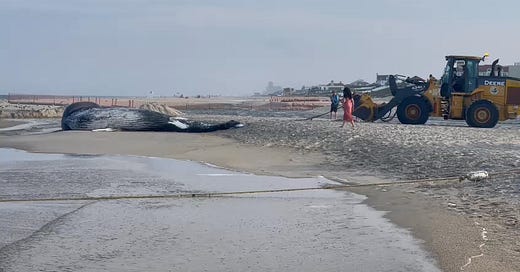A dead whale washed ashore on Takanassee Beach in New Jersey in the early evening yesterday. Police blocked off the area so tractors could be brought in to remove it. “We were sitting on the beach yesterday, and I noticed it when people started running up to it,” said Soraya Nimaroff, who lives nearby. “I’m very sad. It is very sad.”
Yesterday marked the 60th known whale death on the East Coast since Dec 1, 2022. Whale strandings have increased markedly since 2016. The North Atlantic right whales are headed for extinction. Their population has dropped to 340.
There have been 200 humpback strandings and 98 strandings of right whales since 2017.
“It caused us concern enough to ask, ‘What is happening?’” said Cindy Zipf, executive director of the Long Branch-based nonprofit Clean Ocean Action (COA). “We looked into what was different about this December and early January.”
The only thing she and other researchers found was offshore wind exploration. “We looked at shipping, and shipping didn’t seem to be any different,” said Zipf. “The same fishermen were fishing. And the only thing we noticed was the number of IHAs that had been issued.”
IHAs are “incidental harassment authorizations,” or permits to harass whales. In the period since June 2022, the National Oceanographic and Atmospheric Administration (NOAA) has, bizarrely and cruelly, given the wind industry 12 separate, 1-year IHAs, that collectively permit the harassment of 190 critically endangered right whales. Another ten applications for additional IHAs are currently pending.
Blunt and sharp force trauma, according to NOAA, killed the humpback whale found floating in Raritan Bay on May 31. Scientists found lacerations and broken bones across her body.
U.S. government officials insist that the increase in whale deaths has nothing to do with the wind industry’s high-decibel pile driving and boat traffic in previously pristine waters.
But they’re lying. And now we have the proof.





